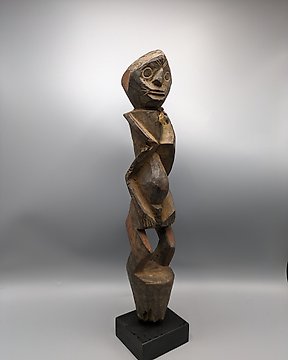
Chamba - Νιγηρία
Αρ. 84127813

Αρ. 84127813

A female Oyo Ibeji, standing on a round base, with short legs and long arms, the carved backbone well emphasised, the breasts small and firm and point forward, the shoulders rounded, the expressive elliptical eyes bordered all around, scarification marks on the forehead and cheeks, the nose and the mouth have the same width, the ears protruding, set towards the back of the head and have a particular shape, the hair-style is high, with a central crest, metal bangles on both wrists, colourful beads around the neck, hips and right ankle; signs of use. Certificate of Origin and provenance.
“When the carving of the Ere Ibeji is completed, the artist is given a feast and payment as determined by the Orishas. Once the figure is brought to the family dwelling, it is placed on a shrine dedicated to Elegba with the hope that the Orisha or soul, which was split in two parts when the twins were born, will now again reside in the figure that represents the dead twin. The sculpted figure is treated and cared for as if it were alive. It is rubbed in sacramental oil, washed, fed, clothed, sung to and prayed to. It is kept standing during the day, and is laid down at night. Often it will be dressed in the same clothing as the living twin, or be decorated in a beaded vest or shown with raised sandals, indicating possible royal connections. They attend to the figure as if it was their child, they feed and wash it. The headdress will be constantly rubbed with Indigo and the body will be rubbed with red wood powder. And as a sign of dignity (in wealthy families), some Ibedji get pearl cloaks. The responsibility of caring for the ibeji is borne by the mother and female family members of subsequent generations. The sculpture is expected to avert evil from the household, strengthen the manifestations of family love, stare down death, illuminate the pathway through the valley of immortality, and bring good fortune to all who treat it with respect and offer it tokens of affection. Conversely, bad fortune and curses may be engendered if the ibeji is ignored." Source:Museum of African Art.
"Yoruba peoples have one of the highest incidents of twin births in the world. As a result, twins are regarded as extraordinary beings protected by Sango, the deity of thunder. They are believed to be capable of bestowing immense wealth upon their families or misfortune to those who do not honor them. Powerful spirits in life, twins are honored with carved memorial figures when they die. These figures, known as ere ibeji (literally meaning ere: sacred image; ibi: born; eji: two), remain a point of access to the spirit of the departed individual. The mother provides ritual care to the figures, bathing, dressing, adorning, and feeding them. Such daily handling is responsible for giving their surface its distinctive patina. Ere ibeji invariably represent their subjects with mature adult physiognomies, and are often crowned with elaborate hairdos." Source:The Met Museum
Πώς να πραγματοποιήσετε αγορές στην Catawiki
1. Ανακαλύψτε κάτι ιδιαίτερο
2. Υποβάλετε την κορυφαία προσφορά
3. Πληρώστε με ασφάλεια